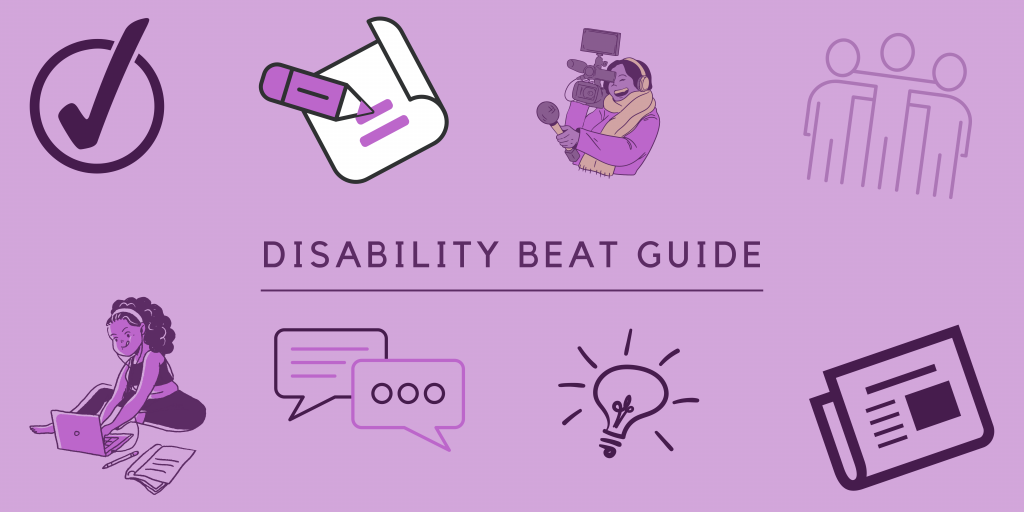
Why cover disability?
- The poverty rate for adults with disabilities is more than twice the rate of adults with no disability.
- The relationship between poverty and disability is complicated. People with disabilities are more likely to become impoverished, and people living in poverty are more likely to have or acquire a disability. There are nuances in this relationship, and it’s important to begin educating yourself when beginning your reporting.
- Stereotypes about people with disabilities persist in our media. You can best serve the community you’re writing about by taking care to avoid stereotypes and misconceptions in your reporting.
Research guide
Here’s a list of databases, reports and studies, institutions and guidance from news organizations to help you form the right questions in your reporting.
If you’re feeling stuck, use the resources below to help answer these questions. They might help you get started on a story or expand on an idea about disability and poverty.
- How many Americans have disabilities?
- How is the federal government protecting people with disabilities?
- What language should I use when reporting on people with disabilities?
- How do I avoid stereotyping or continuing bias in my stories about people with disabilities?
- Are there any recommendations or guides for reporting on people with disabilities?
- What financial challenges affect people with disabilities?
- How does poverty affect people with disabilities? Here is an exemplar story that resulted from asking that question: Children with Developmental Disabilities in Georgia Struggle to Get Needed Care
Essential Reports
The Extra Costs of Living with a Disability in the U.S. — Resetting the Policy Table. By the National Disability Institute, in partnership with the Stony Brook University School of Social Welfare and the Tennessee College of Social Work.
This research finds that a household containing an adult with a disability that limits their ability to work requires, on average, 28% more income to obtain the same standard of living as a similar household without a member with a disability. This report also examines what the U.S. is currently doing to address these extra costs and names policy implications this research might have.
Financial Inequality: Disability, Race and Poverty in America. By the National Disability Institute. Using data from the 2015 American Community Survey, this report explores the relationship between disability and race, examining the poverty rates, level of education and employment percentages among people with disabilities.
The Financial Challenges of Disability. By the National Disability Institute. This graphic shows some of the financial realities of people with disabilities, and points to the need for solutions that advance financial stability for people with disabilities.
Has the Promise Been Kept? Federal Enforcement of Disability Rights Laws (Part 1 & Part 2). These reports examine whether federal agencies tasked with enforcing the Americans with Disabilities Act (ADA), a law which prohibits discrimination on the basis of disability, have done so adequately. These reports assess how federal agencies have implemented and enforced the ADA.
Guidance for News Coverage
Disability Language Style Guide from the National Center on Disability and Journalism at the Walter Cronkite School of Journalism and Mass Communication at Arizona State University.
This style guide covers dozens of words and terms commonly used when referring to disability, and provides guidance on which terms to avoid and which terms are acceptable in news coverage.
Media Guides List from the National Center on Disability and Journalism at the Walter Cronkite School of Journalism and Mass Communication at Arizona State University.
This page provides links to guides from numerous organizations about effective ways to talk about disability in news coverage. Guides come from The Carter Center, the National Disability Rights Network and more.
For Ukraine — and all news coverage — journalists need to pay attention to word choices. From Poynter.
Through a broad examination of word choice, this piece shows how reporting and word choice can either inspire compassion or “lead to othering by reinforcing unconscious bias.” Understanding and accepting this idea is especially necessary in coverage of people with disabilities.
Disability Matters: A toolkit for newsrooms to better serve the disability community from the Donald W. Reynolds Journalism Institute at the University of Missouri.
This toolkit, created in 2022, was produced by Hannah Wise of The New York Times ”as a starting point for journalists or news organizations looking to improve coverage of disability and the accessibility of news products.” Wise notes that more than 61 million Americans live with disabilities and “newsrooms are woefully unprepared to produce journalism that represents the people that make up this community and their needs.” She created a living document (it’s open for community comments), as she describes it, focused on improving coverage and making journalism more accessible.
How to Report With Care on Disability. From The New York Times.
This piece, written by The New York Times’ inaugural disability reporting fellow, addresses how one of the best ways to improve disability reporting is to talk to more disabled people. Author Amanda Morris shares the ways she reports on disabilities in non problematic ways, such as picking stories that are actually newsworthy and serve disabled audiences.
From the Associated Press Stylebook: deaf, Deaf, hard of hearing
The Associated Press changed its style guide in 2022 to capitalize the ‘d’ in Deaf in some cases. From the Associated Press Stylebook newsletter: “Many deaf people who use sign language have a deeply ingrained sense of culture and community built around the experience of deafness and sign language, and use the uppercase form Deaf to signify that culture. The uppercase is acceptable, if used by the person or group, in descriptions such as the cultural Deaf community, Deaf education, Deaf culture, etc.” When using AP Style, deaf should still be lower case when referring to the audiological condition of total or major hearing loss, when relevant to the story.
How to Write About Disability and Poverty: Tips from NPR’s Joe Shapiro
Joe Shapiro from NPR shared his personal tips on how to report on disability and its intersection with poverty with Covering Poverty reporter Jacqueline GaNun. Shapiro stressed the importance of reporting on disability and has reported on the topic for more than 20 years.
Tips for Covering Health and Disability: An Interview with Author Ryan Prior
Ryan Prior has been nationally recognized for his writing on disability, health and chronic illness. He spent the last few years covering COVID-19 for CNN, especially its intersection with disability. That coverage grew into a book called “The Long Haul,” which is about long COVID-19, the myriad lingering health effects people have after a coronavirus infection. As a guest on “The Lead” podcast, Prior discussed how to find compelling health stories and write about disability.
Databases
A part of the U.S. Census Bureau, the American Community Survey collects nationwide data every year on the social, economic, and housing characteristics. You can see specific data about disability in the United States, including the percentage of people with disabilities among people surveyed.
Institutions
National Council on Disability. This council is an independent federal agency that advises the president, Congress, and other federal agencies regarding policies, programs and practices that affect people with disabilities. The council regularly releases reports and recommendations about policies for people with disabilities, which might serve as a starting point to better understand how the federal government makes laws to protect people with disabilities.
National Disability Institute. This institute aims to empower people with disabilities for a better financial future, with multiple projects and programs centered around that goal. This institute also releases reports which examine the financial status and financial literacy of people with disabilities.
National Center on Disability and Journalism at the Walter Cronkite School of Journalism and Mass Communication at Arizona State University. This center provides an abundance of resources for reporting on disability, including a style guide, a reporting guide, and a writing and editing guide.
International Social Role Valorization Association. Social Role Valorization (SRV) is a “set of ideas useful for making positive change in the lives of people disadvantaged because of their status in society.” The International Social Role Valorization Association aims to promote SRV development, education and leadership, and the website has useful articles on how SRV can be applied to support people with disabilities.
Kyra Posey is a graduate student studying journalism at the University of Georgia.

